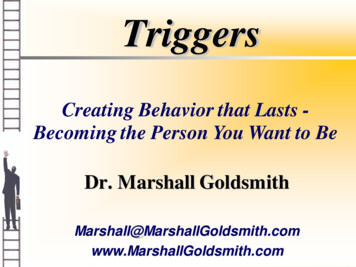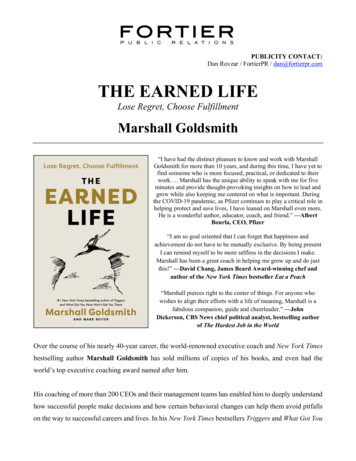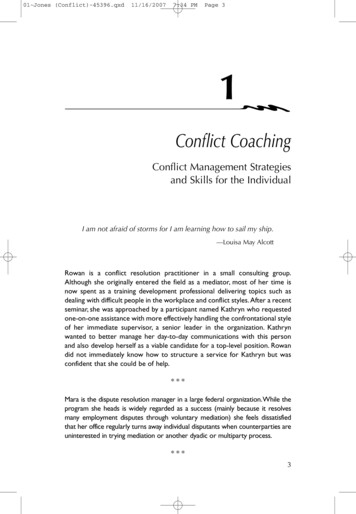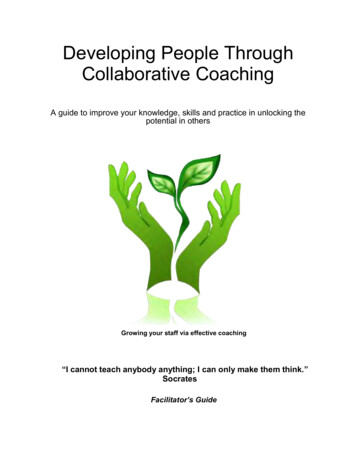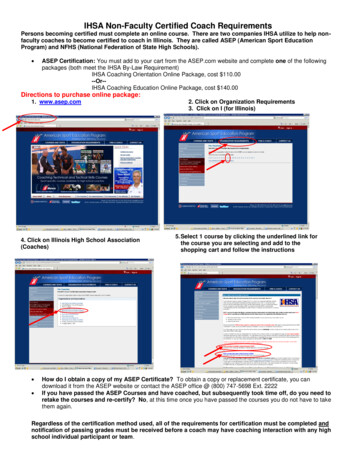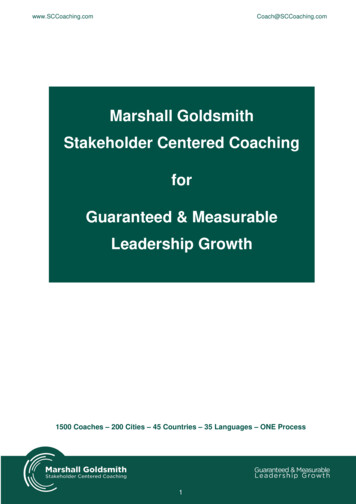
Transcription
www.SCCoaching.comCoach@SCCoaching.comMarshall GoldsmithStakeholder Centered CoachingforGuaranteed & MeasurableLeadership Growth1500 Coaches – 200 Cities – 45 Countries – 35 Languages – ONE Process1
www.SCCoaching.comI.Coach@SCCoaching.comMarshall Goldsmith - World's # 1 Leadership ThinkerMarshall Goldsmith has been recognized as the # 1 leadership thinker in the world by Thinkers50 and HarvardBusiness Review.Marshall Goldsmith's Stakeholder Centered Coaching process hasproven to enable successful people to lead more effectively throughlong-term change in leadership behavior by using a methodology thatis highly effective and time efficient. Furthermore Marshall’s coachingprocess guarantees measurable leadership growth and has beenused by more than 150 of the Fortune 500 companies.Coaching highest level leaders in businessDr. Goldsmith’s Ph.D. is from UCLA’s Anderson School ofManagement where he was recognized as one of 100 distinguishedgraduates in the 75 year history of the School. He teaches executiveeducation at Dartmouth’s Tuck School of Business and frequentlyspeaks at other leading business schools around the world. He alsoserved on the Board of the Peter Drucker Foundation for ten years.Marshall has coached more than 150 CEOs and other top executivesof Fortune companies to measurable improve their leadershipeffectiveness and that of their executive teams.World's # 1 leadership thinkerMarshall Goldsmith has beenrecognized as the # 1 leadershipthinker in the world and the # 7business thinker in the worldThinkers50 and Harvard BusinessReview.World's leading executive coachHis work has been recognized by almost every professionalorganization in his field. Marshall’s acknowledgments include: Institute for Management Studies – Lifetime Achievement Award (one of only two ever awarded) American Management Association - 50 great thinkers and leaders who have influenced the field ofmanagement over the past 80 years Business Week – 50 great leaders in America Wall Street Journal – top ten executive educators Forbes – five most-respected executive coaches Leadership Excellence – top five thinkers on leadership Economic Times (India) – top CEO coaches of America Economist (UK) – most credible executive advisors in the new era of business National Academy of Human Resources – Fellow of the Academy (America’s top HR award) World HRD Congress – 2011 global leader in HR thinking Tata Award (India) – 2011 Global HR Excellence Fast Company – America’s preeminent executive coach Leader to Leader Institute – 2010 Leader of the Future AwardWSJ & NYT Bestselling authorHe is the million-selling (co)author of 35 books, including: TRIGGERS - #1 bestseller at New York Times, Wall Street Journal, and Nielsen BookScan What Got You Here Won’t Get You There – # 1 bestseller at NYT and WSJ, and winner of the HaroldLongman Award for Business Book of the Year MOJO – NYT and WSJ bestseller Succession: Are You Ready? – WSJ bestseller The Leader of the Future - Business Week bestseller American Management Association Handbook of Leadership, US Library Association Choice award winnerHis books have been translated into 28 languages and became bestsellers in eight countries.“We were a very successful team who took our performance to the next level. With Marshall's help we identifiedour two areas and went to work. We used everyone's help and support, exceeded our improvementexpectations and had fun! A team's dedication to continuous improvement combined with Marshall's provenprocess ROCKS!”rdAlan Mulally - CEO Ford Motor Company, 3 Best Leader in the World by Fortune Magazine in 20142
www.SCCoaching.comCoach@SCCoaching.comII. Stakeholder Centered Coaching for Guaranteed & Measurable Leadership GrowthLeadership growth and improving effectiveness take place at work while interacting with stakeholders!Most successful leaders / managers today have a good intellectual understanding of the various managementtools & skills required to lead an organization successfully. Therefore the major leadership challenges formanagers and executives today is NOT understanding the practice of leadership, BUT practicing theirunderstanding of leadership. For successful organizational leaders to become more effective, leadershipchange needs to be positive, sustained, recognized and acknowledged by their stakeholders (and others).Marshall Goldsmith Stakeholder Centered Coaching is a real time on the job process that is highly effective andtime efficient. Accelerating leadership growth and effectiveness is about changing behaviors and creating newprocesses & habits while interacting with others (stakeholders) on the job.Awareness and Acceptance is not enough!Coaching frequently focuses on assessing leadership effectiveness and action planning which results in astrong emphasis on awareness and acceptance. As a result the leader intellectually understands whereleadership change would be desirable and how leadership change would lead to higher effectiveness. Thoughthis step is critical at the outset of the coaching process as it defines the 'intent of the leader to change', it oftentimes results in a long list of good action intentions that might not see the light of day.Action and Acknowledgement is key!Marshall Goldsmith Stakeholder Centered Coaching takes the leadership change process further, outside theleader's office, and into their work environment with the stakeholders. Stakeholders can provide important andinsightful suggestions for behavioral change that would help leaders to become more effective on the job. TheStakeholder Centered Coaching process includes a strong emphasis on action implementation and followthrough to make change stick, thus creating more effective leadership behaviors and habits. Leadership growthhas only real value though implementing change that is sustained, recognized and acknowledged bystakeholders in the workplace. Perception is reality.Stakeholder Centered Coaching guarantees measurable leadership growthThe efficacy of Marshall's Stakeholder Centered Coaching approach has been clearly demonstrated: A comprehensive study among 11,000 business leaders on 4continents concluded that 95% of leaders who consistentlyapplied the Stakeholder Centered Coaching process measurablyimproved their leadership effectiveness. This study is described‘Leadership is a contact sport’. Numerous great top executives, leadership thought leaders andHR development professionals have firsthand experience inworking with Marshall Goldsmith and applying his StakeholderCentered Coaching process for themselves and theirorganizations. Stakeholder Centered Coaching does not require any 'extravaluable time' from busy business executives as the coachingand leadership change process is integrated in their leadershiprole on the job. The Stakeholder Centered Coaching program includes a ‘No Growth No Pay’ success guarantee. Ourcommitment is to support leaders to become more effective in their organization, which is demonstrated inour coaching service fee structure where 50% to 100% of the coaching fees (for the yearlong programs) aresubject to measurable growth in leadership effectiveness of the leaders as assessed by stakeholders.“The coaching process provided not only a fact-based and thought-provoking stimulus to changing personalbehaviors and our organizational culture, but also effective action plans to deliver committed actions to driveresults at all levels. It has been a turning point individually and for the leadership team as a whole. After only afew weeks, there have been noticeable improvements in team behavior and effectiveness.”Paul Richards, President Fonterra SE Asia3
www.SCCoaching.comCoach@SCCoaching.comIII. Stakeholder Centered Coaching Focuses on Follow-through to Measure LeadershipGrowthWhereas executive development and coaching programs generally focus heavily on (intellectual) learning andlittle on follow-through and measuring tangible results, Stakeholder Centered Coaching has turned this on itsear with a strong emphasis on implementation and follow-through to measure growth in leadershipeffectiveness. In the end the only thing that counts is leadership growth i.e. improved leadership (behavior)effectiveness on the job as perceived by stakeholders.As Marshall puts it: "Leadership Change and Coaching are simple but not easy!". Stakeholder CenteredCoaching developed by Marshall Goldsmith, Frank Wagner, Chris Coffey and Will Linssen is a highly effectiveand time efficient process that works as follows:A. Determine 1-2 Leadership Growth Areas Important to the Leader and the OrganizationIn consultation with the coach, the leader selects 1-2 specific behaviors that are important for their leadership00growth (e.g. influencing or delegation). Usually multi-rater leadership assessments (180 – 360 ) and behavioralinterviews are used to determine the aforementioned focus.B. Leading Change Involving Stakeholders (Monthly)The leader selects a handful of stakeholders mostly boss(es), directreports and peers. Throughout the coaching program the leaderinvolves these stakeholders on a monthly basis in the leadershipgrowth process. This creates accountability for the leader toimplement the change, as well as accountability for the stakeholdersto support and to take part in the change process, which mostlyimpacts and benefits the leader's team as a whole.B1. Involve Stakeholders to Capture Feedforward SuggestionsOn a monthly basis the leader asks stakeholders to provide a fewpractical feedforward suggestions as it relates to their leadershipgrowth focus.B2. Stakeholder-Based Monthly Action PlanningThe leader thinks about the feedforward suggestions from the stakeholders and drafts a monthly action plan.This plan includes the issues the leader is committed to execute during the next month. After the coachingsession the leader responds to the stakeholders informing them about their action plan.B3. Change behavior and perception through execution on the jobThroughout the month, the leader implements their action plan and demonstrates to the stakeholders throughtheir actions that they are working to make change visible and become a more effective leader in the twoselected leadership growth areas. Implementing change and following up with stakeholders also alters thestakeholders' perceptions of the leader over time.C. Perception is Reality: Measure Leadership Growth based onStakeholders’ PerceptionThe coach checks in with the stakeholders approximately everyquarter via a short internet based survey, to measure thestakeholders' perceptions on how they see the leader’s effectivenesshas been changing in the two leadership growth areas. This ProgressReview is reported back to the leader (and the sponsor) so that theycan gauge how their leadership change efforts have been perceivedby the stakeholders. This survey also plays a key role inguaranteeing and measuring leadership growth for the leader and theorganization.4
www.SCCoaching.comCoach@SCCoaching.comIV. 1 on 1 Yearlong Executive Coaching Program using Stakeholder Centered Coaching forGuaranteed & Measurable Leadership GrowthMost successful executives today have a good intellectual understanding of the various management toolsrequired to lead an organization successfully. Experience has shown that the same behaviors that contribute toinitial career success often do not guarantee future leadership success. The coaching process therefore focuseson further developing the 'I am successful because of .' behaviors and reducing the 'I am successful despite of.' behaviors. Hereunder a more detailed step by step outline of how a typical coaching process is structuredthough in many cases the process is customized to fit the needs of the leader or the organization.Phase 1. Introduction to Marshall Goldsmith Stakeholder CenteredCoaching ( 2 hours)During the initial session the coaching process is explained to the leader indetail and the coach interviews the leader to understand the leader'sawareness of areas for development as well as their commitment to realleadership change. Leaders can only change if they want to change!Phase 2. Behavioral Interviews and AssessmentsBehavioral Interviews (10-15 hrs)Structured in-depth behavioral interviews with the most importantpeople around the leader produce a detailed & colorful overviewwith real life examples of strengths and areas for development.00(180 – 360 ) structural assessmentThe multi-rater structural assessment provides objectivity and structure tothe assessment process and aside from relevant psychometrical content, itcreates buy-in from the leader. The undermentioned two assessments aremost suitable and most frequently used. However the coach (or the leader)could decide to select another qualified multi-rater assessment.2.1 Global Leader of the Future (GLOF) by Marshall GoldsmithThe GLOF includes all relevant leadership skills to measure theeffectiveness of leaders operating in an international business environment.This unique assessment developed by Marshall Goldsmith and Accenturein collaboration with 200 international organizations on 6 continentsmeasures skills related to leadership communication, managing diversity,global & strategic thinking, leading change, technology savviness, engagingpeople and much more which competencies modern leaders require tosucceed in an globalizing business world.2.2 Leadership Styles Inventory (LSI, Human Synergistics USA)The LSI identifies the underlying thoughts and motivations that guide anindividual's behavior. Often referred to as personal styles, managementstyles and leadership styles, they represent the essence of individualleadership effectiveness. The LSI is a versatile assessment for change atthe individual development level. The LSI measures interpersonaleffectiveness, job related thinking & behavior styles, professionalachievement, personal satisfaction, collaboration with others and the qualityof relationships at work.The assessments in this phase create aside from content (objectivity,structure, color and real life examples), a strong involvement from thestakeholders as well as buy-in and commitment from the leader for thecoaching and leadership growth process.5
www.SCCoaching.comCoach@SCCoaching.comPhase 3. Determine 1-2 leadership growth areas ( 2 hours)From the aforementioned assessments, the leader selects and articulatesareas for leadership growth that would significantly improve theirleadership effectiveness. We typically focus on 1-2 key areas forbehavioral change and skill development. This ensures that maximumattention is paid to the most important behaviors. Over the course of a fewweeks, the coach works with the leader and stakeholders as appropriate,to construct an action plan for improvement in the targeted areas.Phase 4. Stakeholders briefing (30 mins)Leadership growth is not a cognitive process but a daily creation of new behaviors and refinement of existinghabits on the job. Stakeholders facilitate the leadership growth process as the stakeholders: Are experts in their respective fields and as they interact with the leader frequently they should be in aposition to provide solid and practical action suggestions in the predetermined leadership growth areas. Function as quasi accountability partners towards the leader in the leadership growth process. Since thestakeholders are an integral part of the operation of the leader, the stakeholders should subscribe to supportleadership change. Are on the receiving end of the leader’s behavior. They are in an excellent position to assess growth inleadership effectiveness over time. Their perception is reality!The leader supported by the coach will briefly explain the stakeholders their role in the Stakeholder CenteredCoaching process and solicit their support in leadership change for the leader and the team.Phase 5. Leading Change Involving Stakeholders11 monthly coaching and action planning sessions ( 2 hours)Leading Change Involving Stakeholders is based on highly effective and time efficient seven-step processdeveloped by Marshall Goldsmith which process involves stakeholders in leadership change. The leader willuse this seven-step process as foundation for their monthly interaction with stakeholders to manage leadershipchange and improve their leadership effectiveness and that of the team. The seven-step process is brieflyexplained on page 5 above.6
www.SCCoaching.comCoach@SCCoaching.comThe aforementioned steps get the momentum in the leadership change process going. Based on the monthlyfeedforward suggestions from the stakeholders, the leader supported by the coach, completes a monthly actionplan that the leader wants to commit to. The remainder of the coaching sessions focuses on skill developmentand overcoming leadership change challenges mostly, related to stakeholder management or dealing with otherorganizational issues. Throughout this process the coach operates as a soundboard & accountability partner onone hand, and knowledge / experience resource provider (as well as stakeholder advocate) on the other hand.The process of consistent and regular follow-through is a key contributor to leadership growth and improvedeffectiveness, resulting in a changed perception of stakeholders at the same time (see tables below based onMarshall Goldsmith’s research with 11,000 business leaders).Results from 11,000 business leaders on 4 continents (Research: ‘Leadership is a contact sports’)Phase 6. Leadership Growth Progress Reviews (LGPR)After 5, 8 and 11 months into the process we collect the opinions of the stakeholdersto understand & measure their perception of the leader’s growth in the 1-2 leadershipgrowth areas as determined at the outset of the process. At these points in time, theleader can evaluate their progress and identify areas for continued focus. At the endof the yearlong coaching program the final LGPR results are used to measureleadership growth and determine payment of coaching fees.Phase 7. Leader as Coach ( 2 hours)Throughout the year long behavioral coaching program, the leader has mastered theprocess and discipline to incorporate the Stakeholder Centered Coaching processinto their personal leadership style to coach themselves and their direct reports. Thisshould result in the continuous acceleration of leadership success without therequirement of a coach so the leader becomes even more of a coach to their direct reports.A truly powerful system that drives organizational performance and culture change.“Working with Marshall Goldsmith - Stakeholder Centered Coaching has been highly engaging.We learned practical and actionable ways for leaders to get better.”Jack Stoltzfus, Ph.D., Manager of Talent Development, 3M Company7
s that use Marshall Goldsmith Stakeholder Centered Coachingfor Guaranteed & Measurable Leadership GrowthMore than 150 of the Fortune 500 companies and other notable organizations have beenusing Marshall Goldsmith Stakeholder Centered Coaching to measurably grow the leadershipeffectiveness of their executives and their teams. Hereunder, is a sample of some of ourrecent clients."Marshall is a great coach and teacher. He has done a lot to help both me and our high-potential leaders.His approach is practical, useful, helpful and fun!"JP Garnier - CEO GSK - one of the world's 20 most valuable companies, one of the Best PracticesInstitute's top 20 CEOs and winner of France's Chevalier de la Légion d'Honneur"Marshall Goldsmith Stakeholder Centered Coaching has helped me become a more effective leader - asjudged by the people who are most important at Getty Images - our employees. The coaching process hashelped me and my executive team members to be much better positive role models for living our LeadershipPrinciples."Jonathan Klein - CEO Getty Images - the world's leading imagery company. In 2005, American Photomagazine ranked Jonathan and Mark Getty as #1 in their list of The 100 Most Important People inPhotographyMarshall Goldsmith Stakeholder Centered Coaching helped GE human resource professionals customize thecoaching process for use with our high-potential leaders. Our internal HR coaches have achieved outstandingresults with hundreds of our leaders. Marshall's model has been a real win for us!Linda Sharkey - VP Organizational Development and Staffing, GE Capital Solutions - author of"Leveraging HR: How to Develop Leaders in 'Real Time' (in Human Resources in the 20th Century)"8
www.SCCoaching.comCoach@SCCoaching.com1500 Coaches – 200 Cities – 45 Countries – 35 Languages – ONE Processfor Guaranteed & Measurable Leadership GrowthAs a matter of principle Marshall Goldsmith, Chris Coffey, Frank Wagner and Will Linssen have been very activein training leaders to coach and certifying internal and external coaches in order to create the large scaleleadership and culture change organizations are looking for. Their commitment to globalize the StakeholderCentered Coaching process is also illustrated in the comprehensive study among 11,000 business leaders on 4continents which concluded that 95% of leaders who consistently applied the Stakeholder Centered Coachingprocess measurably improved their leadership effectiveness. This study is described ‘Leadership is a contactsports’.At present Marshall Goldsmith Stakeholder Centered Coaching has more than 1500 certified coaches aroundthe world. This vast cadre of experienced executive coaches is a great asset for our clients who can selectcoaches from various backgrounds and levels to fit their coaching needs.If you would like us to introduce experienced or specialized executive coaches to you in any of the countrieshereunder please contact us at: Coach@SCCoaching.com9
TRIGGERS - #1 bestseller at New York Times, Wall Street Journal, and Nielsen BookScan What Got You Here Won't Get You There - # 1 bestseller at NYT and WSJ, and winner of the Harold . Marshall Goldsmith Stakeholder Centered Coaching takes the leadership change process further, outside the leader's office, and into their work environment .

